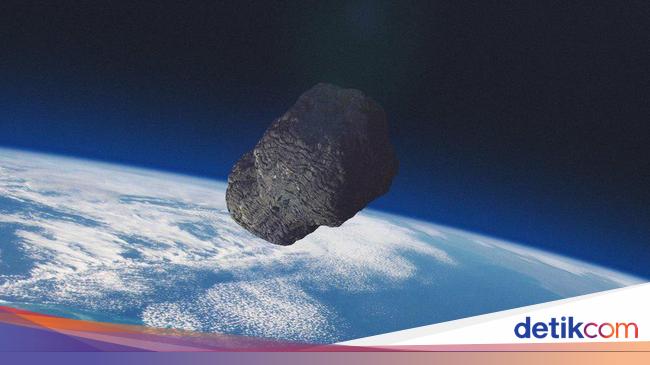Washington DC –
Several asteroids are moving toward Earth, according to the US space agency’s asteroid tracker (NASA), all with a diameter of at least 160 meters, which are considered to be Potentially Hazardous Asteroids (PHAs).
Asteroids are small objects orbiting the Sun. Most of the asteroids in our Solar System are found in the region between Mars and Jupiter, commonly referred to as the asteroid belt.
Occasionally, asteroids collide with each other. The debris from these collisions is known as meteoroids.
If a meteoroid approaches and enters Earth’s atmosphere, it burns and seems to glow. These are called meteors. Because of this appearance, it is also called a shooting star, even though it is not actually a star.
The average size of asteroids that cross the Earth in October and November is much larger than the Giza Pyramids in Egypt, which are 146 meters high and weigh millions of tons.
The first is 1996 VB3, which has a length of between 100 and 230 meters, which crossed the Earth on October 20, about twice the height of the National Monument (Monas) which has a height of 132 meters.
Read also:
When passing, the closest distance to Earth is about 3.2 million kilometers and it is estimated that its movement will have no impact on our planet.
Even though it is far from Earth, NASA still considers it as an object that is close to Earth or near-Earth object (NEO).
How far is 3.2 million kilometers from Earth?
To give an idea, the distance between the Moon and the Earth is 384,000 kilometers.
Then on October 25 will pass asteroid 2017 SJ20, which has a diameter of between 90 and 200 meters. The closest distance to Earth when it passes is 7.1 million kilometers.
In November, there will also be asteroids “visiting” Earth.
The first to come this month is the 2017 asteroid TS3, with a length ranging from 98 to 220 meters. It passes at a distance of about 5.3 million from Earth.
The second guest arrived on November 13, the 2004 EU asteroid, measuring between 170 and 380 meters, which is about the size of the Empire State Building in New York.
Brian Cox, an expert from the UK took a photo at the site of the Earth and asteroid collision. A large crater near Arizona, USA, this is the impact of the collision. (BBC)
This asteroid passes at a distance of 4.2 million kilometers from Earth.
A week later, on November 20, 2016 JG12 will pass, which passes about 5.5 million kilometers from our planet. Not as big as the previous asteroids, but still in the big category because it has a maximum length of 190 meters.
One day later, on November 21, a much larger asteroid crossed Earth: 1982 HR, also known as 3361 Orpheus.
It is estimated that the 1982 HR has a length of 300 meters, almost the same as the height of the Eiffel Tower in Paris, which has a height of 324 meters.
This asteroid passes at a distance of 5.7 million kilometers from Earth.
And finally, on November 29, the 1994 WR12, which has a length of between 92 and 210 meters, will come, traveling at a distance of about 6.1 million kilometers.
Nearly all asteroids that approach in October and November are in the Apollo class, meaning their orbits around the Sun may coincide with Earth’s orbital path. However, it should be noted that the orbits of these asteroids are wider than those of Earth.
The only one not in the Apollo class was the 1994 WR12, which entered the Aten category. That is, it passes through the Earth’s orbit with respect to the Sun, but most of the time it is in the inner circle of Earth’s orbit.
Exploding in Russian space
Periodically asteroids — in various sizes — pass through Earth. Although small, asteroids can still have quite a serious impact on our planet.
For example, on February 15, 2013. An asteroid with a diameter of 17 meters exploded over Chelyabinsk, Russia.
Read also:
The explosion did not cause any casualties, but the shockwave it emitted shattered the windows in six different cities. In addition, 1,500 people had to see a doctor to make sure they were okay.
To his relief, NASA predicts that within the next 100 years, Earth will not be hit by an asteroid from the front. This term refers to asteroids coming from the direction of the Sun.
Asteroids coming from behind are more difficult to detect.
On September 16, the asteroid 2021 SG, which has a length of 42 to 94 meters crossed our Earth and scientists do not know at all. Only the next day, experts found out asteroids coming from this rear direction crossed our Earth.
Although very unlikely, the collision of Earth and an asteroid is still considered the most dangerous natural disaster.
The impact of the collision could change Earth’s life. Experts theorize that the giant dinosaurs became extinct after an asteroid hit Earth 65 million years ago.
That’s why astronomers around the world are working together to monitor the movement of asteroids and calculate their trajectories, to determine if there is a threat to the safety of Earth’s inhabitants.
(nvc/nvc)
– .


